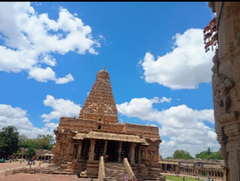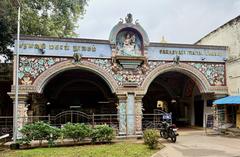
Thanjavur Naganathaswamy Temple: Visiting Hours, Tickets & Complete Guide
Date: 04/07/2025
Introduction
The Naganathaswamy Temple, located in the historic Thanjavur district of Tamil Nadu, is a stunning testament to South Indian religious devotion and Chola architectural genius. Revered as both a Shaivite shrine and a vital Navagraha temple dedicated to Ketu, it attracts pilgrims, history enthusiasts, and cultural travelers alike. Built in the early 11th century under Rajendra Chola I, the temple showcases intricate carvings, inscriptions, and an ekatala vimana, offering a window into royal patronage and Tamil cultural heritage (IAS Point; tamilnadu-favtourism.blogspot.com).
The temple is especially significant as the Kethu Sthalam among the nine Navagraha temples of Tamil Nadu, where devotees seek remedies for Kethu dosha through elaborate rituals. Despite facing periods of neglect and risks from poorly managed renovations, the temple’s original features have been preserved thanks to expert restoration led by the Tamil Nadu Department of Archaeology and support from UNESCO, local communities, and heritage advocates (The Hindu; SwarajyaMag).
This guide presents a comprehensive overview of the temple’s history, religious practices, architectural highlights, practical visitor information (including hours, tickets, and accessibility), major festivals, and nearby attractions, ensuring you can plan the perfect trip to this cultural landmark.
Table of Contents
- Origins and Historical Context
- Architectural Features and Inscriptions
- Decline and Restoration Efforts
- Rituals and Religious Practices
- Festivals and Living Traditions
- Temple Layout and Artistic Heritage
- Visitor Information
- Nearby Attractions
- Visitor Tips
- Frequently Asked Questions (FAQ)
- Summary & Conclusion
- References
Origins and Historical Context
Commissioned by Rajendra Chola I (1012–1044 CE), the Naganathaswamy Temple at Manambadi epitomizes the grandeur of Chola temple architecture and royal piety. Numerous inscriptions from the reigns of Rajendra Chola I and Kulothunga Chola I detail endowments, land grants, and temple administration, illustrating the temple’s central role in both religious and local civic life (IAS Gyan; The Hindu; Bharat Directory).
Architectural Features and Inscriptions
The temple is renowned for its ekatala vimana (single-tiered superstructure), mukha mandapa (front hall), and makara thoranas (ceremonial arches). Its sculptural richness includes depictions of Shiva in multiple forms, goddess Cauvery, and even a rare relief of Rajendra Chola I worshipping Nataraja. Inscriptions on the walls provide valuable historical data about Chola society and temple rituals (IAS Point; MyInd).
Decline and Restoration Efforts
Decline and Threats
In the 21st century, the temple suffered from damage due to poorly executed renovations and the threat of demolition from infrastructure projects. In 2014, the HR&CE Department’s renovation attempt led to partial dismantling, raising alarms among heritage activists (The Hindu). Following advocacy and a UNESCO inspection, restoration efforts shifted to professional hands.
Restoration and Community Engagement
Since July 2023, the Tamil Nadu Department of Archaeology, guided by international conservation principles, has spearheaded the temple’s restoration. The process involves cataloguing dismantled stones, using traditional materials, and engaging local artisans to revive ancient techniques. Local residents, devotees, and heritage groups have all played a role in safeguarding the temple’s cultural significance (SwarajyaMag).
Rituals and Religious Practices
As a major Shaivite and Navagraha temple, Naganathaswamy Temple follows a rigorous daily worship schedule with six poojas marking different times of the day (tripxl.com). Special rituals like the Kethu Dosha Nivarana Pooja—typically conducted on Mondays and during Rahu Kalam—are believed to alleviate astrological afflictions.
Devotees often perform abhishekam (ritual bathing) and light lamps during auspicious periods, especially in the Naga Prathishta Mandapam. The temple’s sacred tanks are used for ritual baths believed to purify and absolve past karmas.
Festivals and Living Traditions
Major Festivals
- Brahmotsavam: Celebrated in the Tamil months of Chithirai (April–May) or Karthigai (November–December), featuring processions, music, and chariot parades.
- Maha Shivaratri: All-night worship and chanting during February or March, attracting large crowds.
- Kandasashti: A six-day festival dedicated to Lord Murugan, marked by dramatic reenactments and devotional fasting.
- Rahu Peyarchi: A unique event marking Rahu’s astrological transit, drawing devotees seeking relief from planetary doshas.
- Navarathri and Vijayadasami: Nine days of pujas and cultural performances, culminating in a grand procession.
- Sekkizhar Vaikasi Pooja: Honors the saint Sekkizhar with readings and community feasts (tripxl.com).
These festivals are vibrant with cultural performances, annadanam (community meals), and traditional music, fostering a strong sense of community.
Temple Layout and Artistic Heritage
The temple complex is centered around the main sanctum (garbhagriha), encircled by subsidiary shrines and spacious mandapas for rituals and processions. Notable features include:
- Ekatala Vimana: A single-tiered tower with detailed stone carvings.
- Mukha Mandapa: Pillared hall adorned with makara thoranas.
- Sculptures: Depictions of Shiva, Parvati (Soundaryanayagi), Ketu (with a unique human face), Vinayaka, Murugan, and more.
- Sacred Tanks: Theerthams like Suriya Pushkarani and Naga theertham are integral to temple rituals (Wikipedia; Indian Holiday; Myoksha).
Visitor Information
Visiting Hours
- Manambadi Naganathaswamy Temple: Open daily from 6:00 AM to 12:00 PM and 4:00 PM to 8:00 PM.
- Keezhaperumpallam Naganathaswamy Temple: Open daily from 6:00 AM to 12:30 PM and 3:00 PM to 8:30 PM.
- Thirunageswaram Naganathaswamy Temple: Open daily from 6:00 AM to 9:00 PM.
Entry Fees & Tickets
- Entry is free at all Naganathaswamy Temples. Donations are welcome and support ongoing maintenance and rituals.
Accessibility
- The temples are accessible by road from Thanjavur, Kumbakonam, Sirkazhi, and Mayiladuthurai.
- Parking and paved pathways are available; assistance for differently-abled visitors can be arranged.
- Modest attire is required; footwear must be removed before entering the temple.
Directions
- Manambadi: ~15 km from Kumbakonam, 10 km from Thanjavur city center.
- Keezhaperumpallam: 2 km from Poompuhar, 93 km from Thanjavur, nearest railway station at Sirkazhi (23 km).
- Thirunageswaram: Close to Kumbakonam and well-connected via public transport.
Photography
- Allowed in the outer precincts; restricted inside sanctums.
- Always check with temple authorities for specific policies.
Nearby Attractions
- Brihadeeswarar Temple: UNESCO World Heritage Site in Thanjavur.
- Poompuhar: Ancient port town rich in archaeological sites.
- Saraswathi Mahal Library & Thanjavur Palace Museum: Explore the region’s rich history and art.
- Mayiladuthurai: Cultural center with historic temples.
Visitor Tips
- Best Time to Visit: November to February for pleasant weather; major festivals offer a vibrant experience.
- Dress Code: Wear clothing that covers shoulders and knees.
- Footwear: Must be removed before entering temple premises.
- Health: Carry water, sunscreen, and hats; expect crowds during festivals.
- Accommodation: Book ahead during festival periods; options range from budget hotels to homestays.
- Guided Tours: Local guides can be hired near the temple or through agencies in Thanjavur and Kumbakonam.
Frequently Asked Questions (FAQ)
Q: What are the visiting hours?
A: Varies by location; typically open from 6:00 AM to 12:00/12:30 PM and 4:00/3:00 PM to 8:00/8:30/9:00 PM.
Q: Is there an entrance fee?
A: No, entry is free; donations are appreciated.
Q: How do I reach the temple?
A: Accessible by road from Thanjavur, Kumbakonam, Sirkazhi, and Mayiladuthurai; buses, taxis, and auto-rickshaws are available.
Q: Is photography allowed?
A: Permitted in outer areas, restricted in sanctums and during rituals.
Q: Are guided tours available?
A: Yes, local guides can be arranged through nearby towns or agencies.
Summary & Conclusion
The Naganathaswamy Temple is a living monument to Tamil Nadu’s spiritual legacy and Chola architectural mastery. Its blend of daily rituals, vibrant festivals, and astrological significance offers visitors a deep cultural and religious experience. Ongoing restoration ensures its grandeur is preserved for future generations. With well-maintained facilities, free entry, and proximity to other historical treasures, the temple is an essential stop for anyone exploring the region (IAS Point; tripxl.com; The Hindu).
For real-time updates, guided tours, and festival notifications, download the Audiala app and follow our social media channels. Enrich your journey with related articles on Chola temples and Thanjavur’s cultural heritage.
References and Further Reading
- IAS Gyan
- The Hindu
- MyInd
- IAS Point
- Bharat Directory
- tamilnadu-favtourism.blogspot.com
- tripxl.com
- Wikipedia
- SwarajyaMag
- Casual Walker
- Indian Holiday
- The Temple Guru
- Myoksha
Image Suggestions:
- Photos of the ekatala vimana, mukha mandapa, stone sculptures, and sacred tanks.
- Maps showing the temple’s location relative to Thanjavur, Kumbakonam, and Poompuhar.
- Restoration work, festival processions, and community events.
Alt tags example: “Naganathaswamy Temple Manambadi ekatala vimana stone carvings”; “Restoration work at Naganathaswamy Temple Thanjavur district”.




